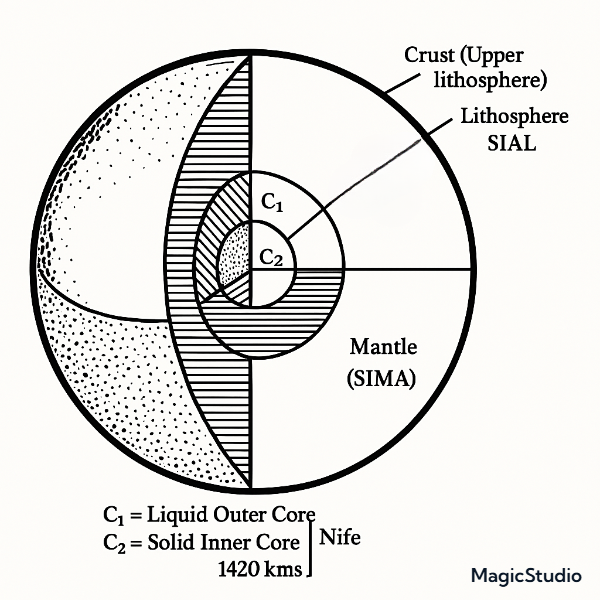The Earth is a dynamic planet, with a complex and diverse interior structure. In this article, we will explore the physical conditions of the Earth’s interior, like temperature, pressure, and composition. Scientists study these layers primarily through seismic waves, which reveal their properties.

- Earth is the only known planet that supports life.
- Like other planets and stars, it is round (spherical) in shape.
- When hot water or lava comes out from deep inside the Earth (like during a volcanic eruption), it shows that the interior is extremely hot.
- Scientists have only been able to dig about 5 km deep into the Earth—because it’s too hot and dangerous to go further.
- To understand what’s inside the Earth, we need to rely on indirect methods, not just digging.
Table of Contents
Why We Can’t Explore Deep Inside the Earth
- Earth is huge, and we can only dig a few kilometers into it through mines or drilling.
- We can’t go deeper because:
- Temperature increases really fast with depth.
- That heat would melt any tools we use for drilling.
So, we understand Earth’s interior mostly by indirect methods—like studying earthquake waves and lava from volcanoes.
Layers of Earth’s Interior
- The Core is the deepest and densest layer. That’s where a lot of Earth’s internal heat is stored.
- The Mantle lies between the Core and the outer crust. It’s made of heavier rocks and stretches a long way.
- The Lithosphere is the outermost, solid layer where we live. The thin Crust is just the top portion of the lithosphere.

Crust (Outer Layer)
-
- Physical Condition: Solid, brittle, and fractured by tectonic activity.
- The crust is the topmost layer of the Earth’s surface—the part we live on.
- It’s made of rocks, which come in many forms:
- Some are hard (like granite),
- Others are soft (like clay),
- Some are loose (like gravel or sand).
Mantle (Middle Layer)
-
- Composition: Semi-solid silicate materials, iron, magnesium
- Physical Condition: Upper mantle is plastic and flowing (allows convection currents), lower mantle is more rigid due to extreme pressure.
Outer Core (Liquid Metal Layer)
-
- Composition: Molten iron and nickel
- Physical Condition: Liquid—movement of this layer generates Earth’s magnetic field (dynamo effect).
Inner Core (Solid Metal Core)
-
- Composition: Solid iron and nickel
- Physical Condition: Solid due to immense pressure, despite extremely high temperature.
Key Influences on Earth’s Interior Conditions
- Temperature increases with depth due to residual heat from Earth’s formation and radioactive decay.
- Pressure rises as depth increases, preventing some materials from melting.
- Density varies—deeper layers are denser due to compression however there are exceptions.
Temperature
The temperature within the Earth’s interior increases with depth. The exact temperature depends on various factors, including the type of material and its position within the Earth’s structure. In general, the temperature increases by about 25 to 30 degrees Celsius per kilometer of depth. At the Earth’s core, temperatures can reach as high as 5000 to 6000 degrees Celsius, which is similar to the surface temperature of the sun.

- As you go deeper, it gets hotter—this is seen in mines, deep wells, and from lava during volcanic eruptions.
- The temperature doesn’t increase evenly everywhere.
- Example: At first, it increases about 1°C every 32 meters.
- At 10 km deep → about 300°C
- At 40 km → about 1200°C
- Example: At first, it increases about 1°C every 32 meters.
- But the Earth’s interior is not fully molten. Why?
- Deep rocks are under huge pressure, so they melt at higher temperatures.
- For example, lava that melts at 1250°C on the surface may need 1400°C at 32 km depth to melt.
Where does all this heat come from?
-
- From radioactive decay—tiny particles inside rocks break down and release heat.
- Earthquake waves also show that temperature varies with depth and layers.
- Overall, the deeper you go, the slower the temperature increases.
Pressure
Pressure within the Earth’s interior is extremely high. At the Earth’s surface, atmospheric pressure is about 1013 millibars, but as you go deeper into the Earth’s interior, the pressure increases significantly. At the boundary between the Earth’s mantle and core, pressures can reach as high as several million atmospheres. These high pressures play a critical role in shaping the Earth’s interior and determining the types of minerals that can form and exist at different depths.
- As you go deeper, pressure increases due to the weight of overlying rocks.
- Near the center of Earth, pressure is 3 to 4 million times more than at sea level.
- This high pressure makes molten material behave more like a plastic solid instead of a free-flowing liquid.
Density
- Density also increases with depth.
- Why? Because:
- Heavier materials sink to the center.
- And higher pressure packs particles more tightly.
- The core is the densest layer of all.
Composition
The Earth’s interior is composed of several distinct layers, each with its own unique composition and properties. The Earth’s crust, the outermost layer, is composed of solid rock and minerals, while the mantle is made up of hot, dense rock that is constantly convecting and flowing. The Earth’s core is composed of iron and nickel and is believed to be a mostly liquid outer core surrounded by a solid inner core.
In addition to these basic elements, the Earth’s interior also contains trace amounts of other elements, such as sulfur, silicon, and oxygen. The exact composition of the Earth’s interior is not well understood, but scientists continue to study the Earth’s interior and use various techniques, such as seismology and geochemistry, to gain a better understanding of its composition and structure.
Conclusion
The physical conditions within the Earth’s interior are diverse and complex, with increasing temperatures, high pressures, and unique compositions at different depths. Understanding these conditions is essential for understanding how our planet works and how it has evolved over time. Scientists continue to study the Earth’s interior to gain a deeper understanding of its structure and composition, and the role that these physical conditions play in shaping the Earth’s surface and landscape.